No-Name Ancient Mahogany Uke
September 30, 2007
Another Ebay treasure.
I think I lucked out on this one. This uke is in good structural shape overall. It looks like it hails from the 1920’s, but this might be wishful thinking. There are no markings, no clues that I can find to identify this uke. I’m a novice though, it’s probably some super-common factory-uke, but I don’t know. If anyone out there can identify this puppy…any help would be greatly appreciated.
It arrived pretty much as it appears here. Before I took any pictures, I started soaking the old glue off the body where the bridge was attached. Its a bit cleaner in that area, but the otherwise the uke is as found.
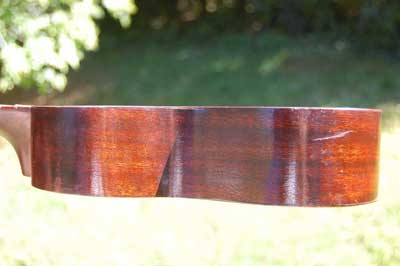
I have been looking for a uke that is more or less “original” – original tuners, original finish etc. A uke that is as close to original as I can find. Most of the older ukes within in my price range on ebay are fairly sad looking.
It is made of paper-thin mahogany. It has the original tuning pegs. There is a dark seam strip on the end – I have no idea what wood this is made of, but its dark. The uke has an oddly off-center back-bow. You can sort of see what I am talking about in the first picture.
This uke is a petite 13″ scale. A lot smaller and more delicately made than any uke I have had before. I really like the shapely and graceful lines. It is several steps above most of the clodhopper ukes coming out of Asia at the moment. From my small experience bending uke sides, the deeper the bend, the more difficult the bending. This uke is very carefully made.
Repairs should be fairly easy (insert sound of knocking on wood here). Probably fabricate a new bridge – the chip out of the top plate was still firmly attached to the old bridge. So that will be easy, I see one closed body crack on the back, one closed side crack, and a 1″ section of seam opening on the back. One brace is loose inside – fabricating a clamp for this spot will be harder than actually gluing the brace.
The hardest operation will be making a decent 12th fret. I think this size of brass fretwire is totally unavailable these days. I’ll either make it from sheet like a bar fret, or fool around with model railroad track that is about the same size.
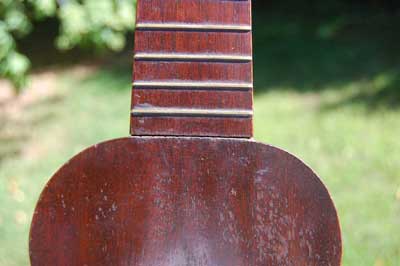
The finish is decent (looks like it was refinished long ago). The scratches look like they can be rubbed out rather than slathering the uke in new varnish.
The bridge is puzzling – it seems as if it fell off at some point and was reglued with something like Duco cement (?? whatever it is, the stuff is still pliable and pops off the old hide-glue like it was stuck on wax-paper). It was probably at this point where some madman (or madwoman) attacked the top around the bridge with sand-paper. Pity they didnt manage to actually sand any of the old glue off – just scratched the heck out of the finish.
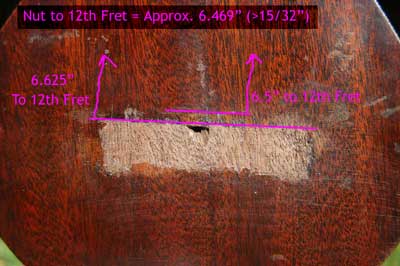
So there is something funny going on here…either the bridge was reglued 1/4″ to 1/2″ too far back on the top? Or this is the wrong bridge. I see some evidence of the bridge being up about 1/8″ higher on the body than the most recent location, but not enough far enough to make sense of the measurements. I think that this uke lost its original bridge and had a replacement (the wrong replacement) botched onto it, by the mysterious sandpaper bandit.
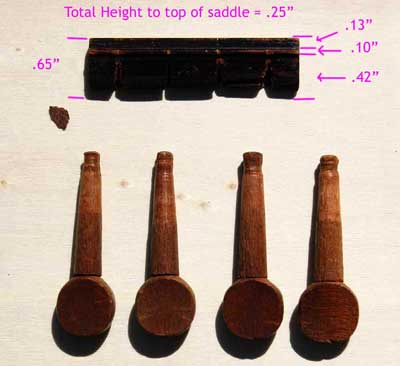
The bridge that came with this uke has a built-in saddle. Dead-on 1/4″ tall. The string notches are tapered holes drilled into the end of the bridge then opened with saw cuts. I think I remember seeing this style on several different brands of older ukes.
The bridge is a good match to the uke in color and age, but I can’t make the measurements jibe. For this uke to be tuneable…this bridge would need to be placed on the top in a space where there is strong (original?) varnish.
I have not finished puzzling-out this uke yet, but there seems to be no way I can think of that this is the right bridge for the uke. This bridge came with the “original” strings still attached. One gut and two nylon and one unaccounted for. Who knows?
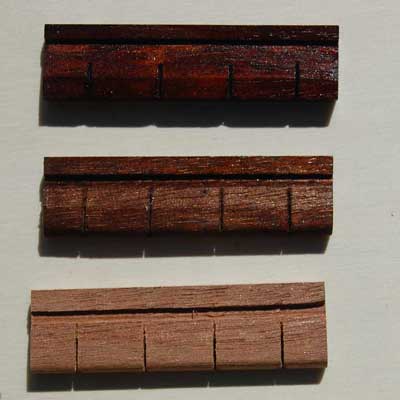
Last minute pic of some replacement bridges I am working on. All are from an old Honduras Mahogany scrap I had lying around. The bottom is not quite finished being shaped and is still raw mahogany. I treated the other two with dichromate to see if I can get a decent match with the color of the original wood. The center is the dichromate, the top has a single coat of dark seedlac over the dichromate. The color match looks good. Sorry about the dark shadows in the photo.
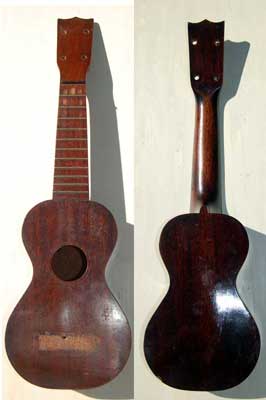
December 13, 2007 at 7:38 am
Hello I started poking around more in your blog 🙂 Is it possible this uke you bought is someones ‘build it yourself’ ukulele kit project that got botched? that would explain the lack of logo and the screwy bridge. it’s just a thought.
http://www.hanalima.com/Merchant2/merchant.mvc?Screen=PROD&Store_Code=HL&Product_Code=P-HKIT2&Category_Code=P
notice the lack of logo. no reputable company wants their name on someones uke-building 101 mess.
hehehe!
January 5, 2008 at 5:26 pm
Hi, Sorry about the delay…I got sucked into the holidaze pretty heavily this year. Just getting my feet back on the ground.
If this is uke is a homemade jobber its a damn fine example. The wood seems too thin and the overall construction is just too clean. I think the thing was a factory uke with some horrible home-made repairs. It just doesnt feel like someones first attempt at instrument making
The uke is very old. The patina and even the smell is ancient.
There is an old plan (20’s?) from Popular Mechanics (? or some magazine like that). I have it somewhere, but I cant lay my hands on it. I remember the plan being for a tiny uke. I need to look into that. Hmm…